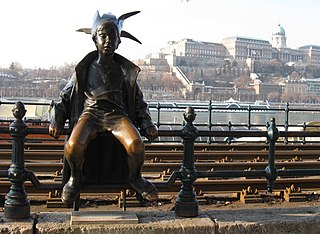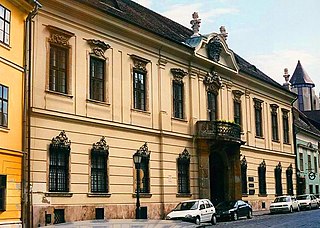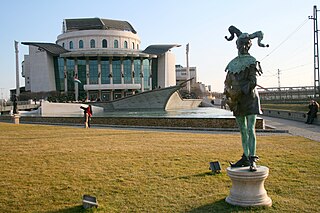 W
WA38 is an entertainment and cultural venue on the Danube river in Budapest, Hungary, opened on 30 April 2003. Its structure repurposes a decommissioned stone-carrier ship that operated in Ukraine and is now anchored permanently to the bottom of Petofi Bridge. The venue variously encompasses a ruin bar, restaurant, exhibition hall, dancefloor, and concert hall.
 W
WAuróra is a cultural and community place located in the 8th district of Budapest, Hungary. A well-known site of the city's underground music and art scene, it also serves as a hub for Hungarian NGOs. Its organisational model is based on participative democracy. Auróra has been a well-known target for the Hungarian government's crackdown on civil organisations. It has been named after Károly Kisfaludy's literary journal of the same name.
 W
WBatthyány's sanctuary lamp is a national monument, located at the corner of Báthory Street and Hold Street in Lipótváros, Budapest, Hungary. It sits on the former location of the courtyard of the New Building, where Count Lajos Batthyány (1807–1849), the first Prime Minister of Hungary, was executed on 6th October 1849.
 W
WBauhaus was a dominant architectural tendency in Budapest, the capital of Hungary, between 1930 and 1948. Large residential buildings, cinemas, churches and even an airport was built in this style, in particular in Újlipótváros in the XIII district, and Városmajor and Pasarét in the II district of the city.
 W
WThe Budapest Opera Ball is an annual Hungarian society event taking place in the building of the Budapest Opera (Operaház) on the last Saturday of the carnival season, usually late February. On this occasion the stage and the auditorium of the Opera is transformed into a huge ballroom. The dress code is evening dress: white tie and tailcoat for men, floor-length gowns for women. The ball is opened by more than a hundred debutante dancers after a show consisting of selected arias, followed by the Alles Walzer with people dancing until dawn. Recent international guests include Montserrat Caballé, Ornella Muti, Yevgeny Nesterenko, Walter Berry, Heinz Zednik, Katia Ricciarelli, Patrizio Buanne, Catherine Deneuve, Katarina Witt, Gina Lollobrigida, Daryl Hannah, and Guy de Rothschild. Besides such guests as these, the balls are highlighted by the best-known Hungarian opera singers.
 W
WBudapest Pride, or Budapest Pride Film and Cultural Festival, is Hungary's largest annual LGBT event. Of the week-long festival, the march is the most visible event. The march has historically been known under several names, including Budapest Gay Dignity Procession, and has taken place each year since 1997, usually on the first Saturday of July, proceeding along Budapest's most expansive thoroughfare, Andrássy Avenue, between the City Park (Városliget) and Elizabeth Square. Though much smaller in scale than similar gay pride parades in Western Europe and the Americas, around one to two thousand marchers typically participate in the Budapest procession. Radical right-wing demonstrators and hooligans have severely disrupted the Budapest Pride marches held in 2007 and 2008, casting uncertainty over the future of the event. However, Budapest Pride has been held successfully in the intervening years, with minimal incidents.
 W
WThe coat of arms of Budapest has existed since 1873, when the three main cities next the Danube river were united in one after existing during a millennium separately. The city committee that was planning the city's unification asked the master-painter Lajos Friedrich that design the coat of arms based in the cities' previous symbols and coats.
 W
WThe Comedy Theatre of Budapest is a theatre in Budapest. Starting in the turn of the 19th and 20th century as an opposition to the conservative National Theatre, it became a pioneer institution of Hungarian drama, and one of the oldest theatres of the city still in operation.
 W
WCarmelite Church of Buda (natively: Karmelita kolostor) is the current seat of the Prime Minister of Hungary. The monastery was built in 1736 by the Carmelite order on the former site of a mosque that was destroyed in 1686 during the siege that liberated Buda from Ottoman occupation. The order received the real estate in 1693 and completed the new monastery and church by 1736, but it was consecrated only in 1763. Two decades later, Emperor Joseph II disbanded the order and converted the property into a theater by imperial order in 1786, "for the delectation of high-ranking court officials". Some notable performances included Beethoven and the premiere of Bánk Bán.
 W
WThe Erkel Theatre is a theatre in Budapest, Hungary. Being the largest public building in the city for decades, it was made part of the Hungarian State Opera House in 1951.
 W
WThe Erzsébetliget Theatre is a theatre in Mátyásföld, Budapest.
 W
WThe flag of Budapest is the official municipal flag of Budapest, Hungary. The current design features the city's coat of arms on a white field. The top and bottom edges of the flag are occupied by alternating red and green isosceles triangles. It has been in effect since 15 September 2011, following a decree from the General Assembly of Budapest.
 W
WFővárosi Szabó Ervin Könyvtár is the largest library network in Budapest, Hungary.
 W
WThe Liszt Ferenc Academy of Music is a music university and a concert hall in Budapest, Hungary, founded on November 14, 1875. It is home to the Liszt Collection, which features several valuable books and manuscripts donated by Franz Liszt upon his death, and the AVISO studio, a collaboration between the governments of Hungary and Japan to provide sound recording equipment and training for students. The Liszt Ferenc Academy of Music was founded by Franz Liszt himself.
 W
WThe Hungarian State Opera is the national opera company of Hungary. Located in Budapest, it is a busy institution, with over 200 operas each calendar year, on top of extensive educational programs, ballet, and musical theatre. The company employs 150 singers, a 200 member orchestra, and a 200 member chorus. Performances take place in the Hungarian State Opera House and the Erkel Theatre.
 W
WThe Kálmán Makláry Fine Arts gallery is a showcase for artists of the Post-War School of Paris. The gallery is a member of Syndicat National des Antiquaires Négociants en objets d'Art Tableaux anciens et modernes de France.
 W
WThe original 50 cm statuette of the Little Princess (Kiskirálylány) Statue sitting on the railings of the Danube promenade in Budapest, Hungary was created by László Marton (1925–2008) Munkácsy- and Kossuth Prize-winning sculptor in 1972.
 W
WThe Magyar Theatre is a theatre operating in Budapest, Hungary. Its company started on August 22, 1837 as the first major Hungarian-language theatrical company in the city. They operated under this label until August 8, 1840, when the name was changed to National Theatre of Hungary. Switching homes two times, the company moved to its current building in 1966. The name Magyar Theatre was restored on September 1, 2000, with the opening of the new National Theatre.
 W
WMarket in Banska Bystrica is an 1889 painting by the Slovak artist Dominik Skutecký.
 W
WMüpa Budapest is a building in Ferencváros, Budapest, Hungary, officially opened in March 2005. It is located near Rákóczi Bridge and was designed by Zoboky, Demeter and Partners Architectural Office. The National Theatre, which opened in 2002, is located next to it.
 W
WBudapest is the capital and largest city of Hungary; it has long been an important part of the music of Hungary. Budapest's music history has included the composers Franz Liszt, Ernő Dohnányi, Zoltán Kodály and Béla Bartók and the opera composer Ferenc Erkel.
 W
WThe National Széchényi Library (OSZK) is a library in Budapest, Hungary. It is one of two Hungarian national libraries, the other being University of Debrecen Library.
 W
WThe National Theatre, located in Budapest originally opened in 1837. Since then, it has occupied several locations, including the original building at Kerepesi Street, the People's Theatre at Blaha Lujza Square, as well as Hevesi Sándor Square, its longest temporary location. It currently occupies the National Theatre building, which opened March 15, 2002.
 W
WThe Hungarian State Opera House is a neo-Renaissance opera house located in central Budapest, on Andrássy út. Originally known as the Hungarian Royal Opera House, it was designed by Miklós Ybl, a major figure of 19th-century Hungarian architecture. Construction began in 1875, funded by the city of Budapest and by Emperor Franz Joseph I of Austria-Hungary, and the new house opened to the public on the 27 September 1884. Before the closure of the "Népszínház" in Budapest, it was the third largest opera building in the city; today it is the second largest opera house in Budapest and in Hungary.
 W
WThe Shoes on the Danube Bank is a memorial erected on April 16 2005, in Budapest, Hungary. Conceived by film director Can Togay, he created it on the east bank of the Danube River with sculptor Gyula Pauer to honour the Jews who were massacred by Fascist Hungarian militia belonging to the Arrow Cross Party in Budapest during the Second World War. They were ordered to take off their shoes, and were shot at the edge of the water so that their bodies fell into the river and were carried away. It represents their shoes left behind on the bank.
 W
WThe Sziget Festival is one of the largest music and cultural festivals in Europe. It is held every August in northern Budapest, Hungary, on Óbudai-sziget, a leafy 108-hectare (266-acre) island on the Danube. More than 1,000 performances take place each year.
 W
WVigadó is Budapest's second largest concert hall, located on the Eastern bank of the Danube in Budapest, Hungary.